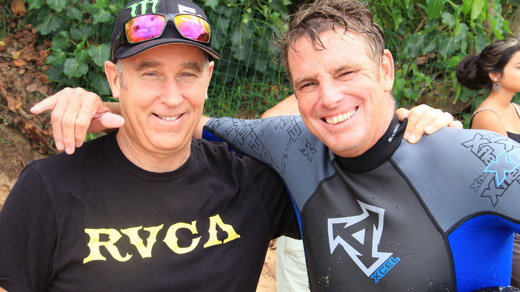How Ubiquity Broadcasting Captures Action Footage for Streaming, TV, and Digital Cinema
Ubiquity Broadcasting, based in San Juan Capistrano, CA, is dedicated to platform- and screen-independent content creation. That means that when the company captures action-sports footage, it’s meant to appear in a variety of different venues, whether it’s streamed live to your iPhone or iPad or rebroadcast in a digital auditorium at your local multiplex. Before becoming Ubiquity’s CEO, Chris Carmichael was a co-founder of Sponsor Me, a self-described “interactive community dedicated to the action sports lifestyle,” and a primary challenge for Ubiquity to date has been capturing up-close and personal footage of Sponsor Me events, notably live surfing contests. The company recently opened a 30,000-square-foot stereo-3D production facility with three soundstages.

Cinematographer Mike Prickett, right, with Ubiquity Broadcast CEO Chris Carmichael
Cinematographer Mike Prickett, an IMAX filmmaker who has lots of experience riding the waves with fragile and expensive cameras, helps make sure the company’s gear is up to snuff when it comes time to head to the beach and even dip into the water. For the Sponsor Me 2011 Sunset Open, broadcast from the North Shore of Oahu in Hawaii, Prickett used microwave systems from Gearhouse Broadcast that were integrated with Ubiquity’s patented IP backhaul platform. That allowed camera operators to head out a mile from shore in tiny boats, shoot live footage from the water, and send it via microwave transmission to the beach. From there, it was re-transmitted live over the Internet.
Prickett says water shoots often cause problems with digital cameras for one reason – condensation. That’s why he’s worked with Ubiquity on a small stereo 35mm film camera rig that can shoot at up to 200 fps. “Other cameras don’t get a very high frame rate, and digital cameras would heat up,” he explains. “After a long time using them in the water. you’d have condensation problems. Using these high-speed 35mm cameras, we can be in the water all day. When a UFO or a whale pops up, we’re ready to shoot instead of being all fogged up.
So Prickett’s approach to water shoots generally involves a mix of film and digital shooting. “We use the Red cameras as well,” he says. “Right now we’re waiting on the Epic, but those cameras still do get kind of hot, so we’ll probably still use the film camera in certain situations. It’s a good balance of digital and film.”
Shooting the Pipe
At the Da Hui Backdoor Shootout in January, Prickett and Ubiquity captured 2D and 3D footage of surfers on the famed Banzai Pipeline with plans to repurpose the material for 3D TV, digital cinema, and eventually DVD and Blu-ray. “We’re building up a library of footage,” Prickett says. “We’re putting it together and digitizing it now to create a big stock library system where people can look for footage. We’ve been shooting material on the beauty of Tahiti, as well, and we just did a 3D IMAX movie called The Ultimate Wave on which we unveiled footage from the 35mm 3D camera that we built.”
That film was shot mostly in IMAX and VistaVision formats, but POV footage from the surfboard-mounted 35mm camera system was blown up to IMAX from Super 35. “We really needed to slow down the action for surfing, so that’s why we needed the high-speed film cameras,” he says. “And the Super 35 looked really nice intercut with the larger stock.”
Prickett does some work at Ubiquity’s indoor studios, but he spends the vast majority of his time out in the field, figuring out ways to get new angles on familiar subjects. “If the waves get big anywhere in the world,” he promises, “we’ll get out there and grab it.”
For more information: www.ubiquitybc.com; www.prickettfilms.com.
Did you enjoy this article? Sign up to receive the StudioDaily Fix eletter containing the latest stories, including news, videos, interviews, reviews and more.









Leave a Reply